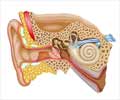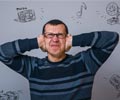Cotton-tipped swabs' use for routinely cleaning out earwax may prove harmful because the wax actually plays a critical protective function for the ear, say health care experts.
Cotton-tipped swabs' use for routinely cleaning out "earwax" may prove harmful because the wax actually plays a critical protective function for the ear, say health care experts.
Earwax is not actually wax, but a water-soluble mixture of secretions produced in the outer third of the ear canal, along with hair and dead skin.In the first published guidelines about removing wax from the ear, health care professionals say that the mixture serves a critical protective function for the ear and should not be removed unless it is causing symptoms or interfering with assessments of the ear.
"Unfortunately, many people feel the need to manually remove earwax, called cerumen, which serves an important protective function for the ear," said the guidelines' lead author, Dr. Peter Roland, chairman of otolaryngology - head and neck surgery at UT Southwestern Medical Center.
"Cotton swabs and some other home remedies can push cerumen further into the canal, potentially foiling the natural removal process and instead cause build-up, known as impaction," Dr. Roland added.
The guidelines say that wax-dissolving agents, irrigation or ear syringing, and suction devices or other specialty instruments should always be used under supervised care to avoid damaging the ear or further impaction.
They also warn against using cotton-tipped swabs, and the home use of oral jet irrigators.
Advertisement
The guidelines were created with input from family practitioners, paediatricians, internists, nurses, audiologists and emergency room doctors, and have been endorsed by the American Academy of Otolaryngology - Head and Neck Surgery.
"When cerumen builds to the point of causing symptoms such as pain, ringing, itching or hearing problems, it's a sign you should see a physician," said Dr. Roland, who also serves as chief of paediatric otology at Children's Medical Center Dallas.
"The complications from cerumen impaction can be painful and include infections and hearing loss. It is hoped that these guidelines will give clinicians the tools they need to spot an issue early and avoid serious outcomes," Dr. Roland added.
The guidelines, appearing in a supplement to the September issue of Otolaryngology - Head and Neck Surgery, will be presented at the academy's September meeting in Chicago.
Source-ANI
SRM








